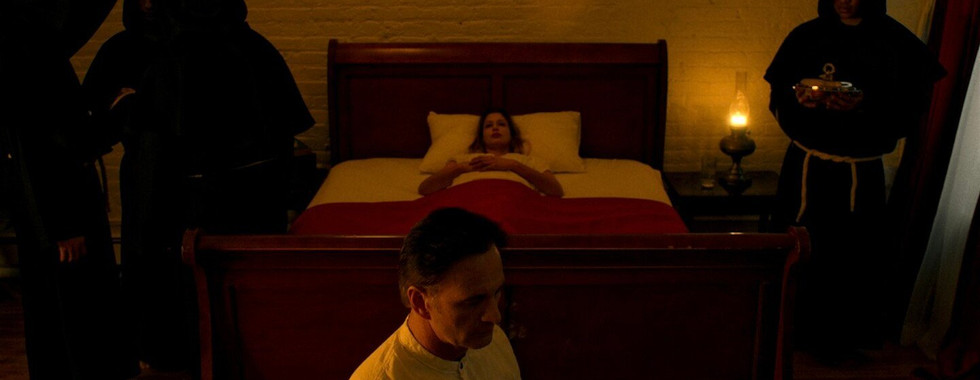Review of the movie “Exquisite Cadaver”

The movie "Exquisite Cadaver" begins in a surrealistic setting with unfamiliar faces and the voice of a narrator telling us about his wife's death, but due to the scene design and atmosphere, we cannot take his words seriously and it all seems like beginning of a game. Director Ren Zheng intelligently takes us into a world full of doubt, where every event can be ironic, unreal, or even contradictory to what we see. He successfully, from the starting point and with influencing beginning draws us into an entangled and psychotic maze of the work. A maze which proceeding in it makes us feel more lost. For instance, in a scene when Mathilda is brushing her hair with a skull in her other hand. At first glance, it seems it’s the husband who’s brushing her hair (maybe for the color of his clothes), but then we find he’s her lover. He speaks of the beauty of her hair and Mathilda responds implicating a death wish. The bitter conversation of these two or the skull in her hand are not the only odds of the scene. You can trace desire for surrealism in decoration, stage design and lighting style.
The film constantly moves between past and present, confusing us about time and place. Probably this is the reason why we think it a fluid and elusive work and hard to trace. "Exquisite Cadaver" follows different characters and makes them appear as the central figure before letting them go. The narrative also constantly changes; when the narration pattern is discerned, the narrator’s performance changes.
The movie begins with the voice of a narrator who talks about his wife's death. The audience empathizes with him and his indifference towards his wife's death, and when talking to a priest in a church. However, the narrator changes and we hear the voice of the wife’s lover who continues the story. Changing the narrator changes the point of view and we go back to the man's memories and see Mathilda. Mathilda, who even when sleeping in her lover's arms, presses a skull to her chest. She talks about death and the meaninglessness of life that can be read in her eyes.

The film excels in characterization. Undoubtedly, Mathilda is the central character of the movie, but she is a character who is already dead and we only see her comes to life once, and it’s in her lover's memories. In that one instance, Mathilda appears so impactful, bitter, yet fragile and vulnerable that her presence lingers throughout the film. We only see Mathilda alive once, and in all the other scenes, she’s in her coffin. By not showing Mathilda, the film seems to get closer to her. In her absence, we see her more and understand more about life through her death. We understand Mathilda through the words of others, through her lover's memories, and through her husband's actions and behavior. It is through others that we realize Mathilda had a unique perspective on life and had an impact on others. One Ren Zheng's tact as a screenwriter is keeping Mathilda at a distance. From the very beginning, it is announced that she is dead and her death, her life, her relationships, her infidelity to her husband, and her beliefs become more of a puzzle for the audience to solve.

The movie “Exquisite Cadaver” is visually stunning. The scene design and costumes are well-crafted, the lighting is clearly thought out, and the decorations are alluring. They are symbolic without being artificial and attractive without drawing more attention than the story itself. They create a suitable atmosphere for advancing the plot. Look at the warm tonality of colors in the opening scene and the colors we see in that scene (including the similarity of the color of the bird's blood and Mathilda's bedding). Look at the diversity of lighting in scenes whose sequence was supposed to keep the audience from getting bored. The first scene ends with a view of Mathilda on her deathbed, and the second scene begins with a view of Mathilda in a coffin, this time in a church. The difference in lighting between these two scenes shows that the filmmaker wanted to prevent color and lighting uniformity. The church scene makes us emerge from its darkness and gloominess, and this sequence of dark and light scenes continues until the end of the movie.
“Exquisite Cadaver” is a impressive film for cinematography. The scenes are mostly static, with the camera remaining fixed and the action taking place within the frame. Until the final scene, where the camera moves more, the shots are generally static or only slightly moving to follow something, but the final scene lasts almost three minutes and has more movement. The film's visual climax is very captivating and a fitting end to this short story. The costumes are also noteworthy, with Mathilda's brief appearance leaving a lasting impression on the audience. She appears as a question mark, a puzzle that cannot be solved. In this surrealist and fantasy-inclined film, the woman's performance is justified while remaining realistic. Other performances are equally good, including Mathilda's lover, who has a brief appearance, and her husband, who is present almost from beginning to end. All performances are well arranged to be efficient in the short film. The director's style is understated and unpretentious, emphasizing the eerie atmosphere of the film with restraint and kind of quietness. “Exquisite Cadaver” worth watching twice and noticing different aspects of it.

















Comments